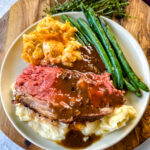
Garlic Butter Prime Rib (Bone-in or Boneless)
Cooking a prime rib standing rib roast, might seem like a daunting, intimidating task, especially when dealing with a piece of meat that's both luxurious and expensive. This Garlic Butter Prime Rib recipe is here to walk you through every step of the process, from selecting the right cut to achieving a flawlessly cooked roast with a perfectly seasoned crust.
Servings 10 servings
Calories 592kcal
Ingredients
- 4-7 pound standing rib roast/prime rib Mine was about 5 pounds.
- kosher salt or sea salt To Taste
- ½ cup room temperature unsalted butter Use more as needed if necessary for your size prime rib.
- 1 tablespoon finely chopped parsley Fresh or dried.
- 6 garlic cloves Minced
- 2 fresh rosemary sprigs
- 3-6 fresh thyme sprigs
- ½ cup sliced or diced onions Optional; really only needed if you plan to make Au Jus/Gravy
Standard Seasoned Prime Rib
- 1-2 teaspoons smoked paprika
- 1-2 teaspoons onion powder
- salt and pepper to taste
Creole Seasoned Prime Rib
- 1-2 tablespoons Creole Seasoning Adjust to suit your taste and the size of your roast.
- 1 teaspoon smoked paprika
Instructions
- Remove the prime rib from the fridge and allow it to come to room temperature. This can take 2-3 hours depending on the size of the roast you have. Sprinkle salt onto each side of the prime rib. The salt will penetrate the meat as it comes to room temperature.
- Preheat the oven to 500 degrees.
- Combine the room temperature butter with the garlic, parsley, and spices. Stir to completely mix. (You will use the onions, rosemary, and thyme later).
- Pat the prime rib dry. Ensure it is completely dry, othewise you will have a hard time getting the butter and spices to stick.
- Rub the entire prime rib roast with the seasoned herb butter. Add the onions (optional) and herbs (rosemary and thyme) to the pan.
- Place the prime rib roast bone-side down and fat cap-side up in a cast iron skillet or roasting pan with rack. Having the fat cap side (the thick layer of fat on the outside of the meat) on top allows the fat to melt down into the prime rib as cooks for extra flavor.If you have a cut of meat without a fat cap, ensure the roast is placed bone side down.
- Place the pan in the oven for 20 minutes or for however long it takes for the exterior meat to form a crust. It may take a few minutes longer.
- Adjust the heat on the oven to 325 degrees. Continue to cook the prime rib until it reaches your desired level of doneness. Use a meat thermometer and remove the prime rib from the oven when it reaches the following:Rare: 113-120 degreesMedium Rare: 123-127 degreesMedium: 128-135 degreesMedium Well: 138-145 degreesWell Done: 148-155 degreesWhen you remove the roast from the oven, its internal temperature will continue to rise by a few degrees due to the residual heat within the meat.
- Allow the prime rib to rest for 45-60 minutes prior to slicing. During this time, the internal temperature will continue to rise, and the juices within the meat will redistribute, resulting in a juicier and more flavorful roast. If you slice too soon you will likely end up with dry meat.
Notes
The prime rib is a large piece of meat, so you typically should not have to worry about sprinkling too much salt on it as it rests. If salt bothers you, then skip this step.
The measurement noted for the spices and butter are a guide. Every piece of meat is different. The size you purchase will likely be different from mine so you will need to use your judgment. If you need more butter than the recipe states, use it. Ensure the prime rib is fully coated with butter and spices for optimal flavor. You don't want bland meat.
Keep a close eye and monitor the roast while it cooks. You don’t want to overcook it. Overcooked meat will have an interior that is uniformly cooked but lacks the desired level of juiciness. The meat might have a pale color rather than the pinkish hue associated with medium-rare or rare doneness.
You don’t have to use kitchen twine. I often do not. It can be useful if you need to secure the meat. The twine will help create a uniform shape which will assist in an even cooking process for the entire roast. This is something to consider if you have a very unevenly sliced roast.
Nutrition
Serving: 0.5pound | Calories: 592kcal | Carbohydrates: 1g | Protein: 64g | Fat: 36g